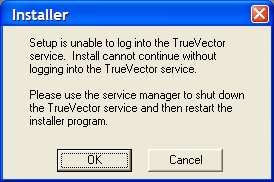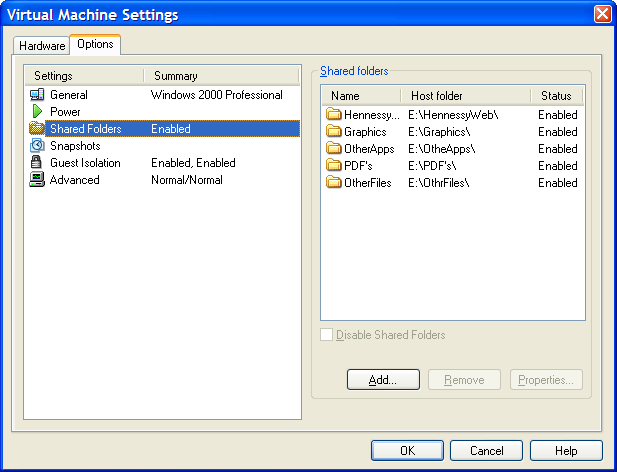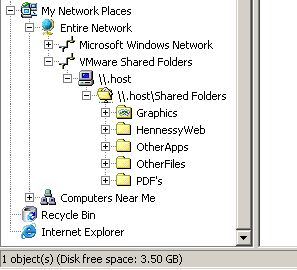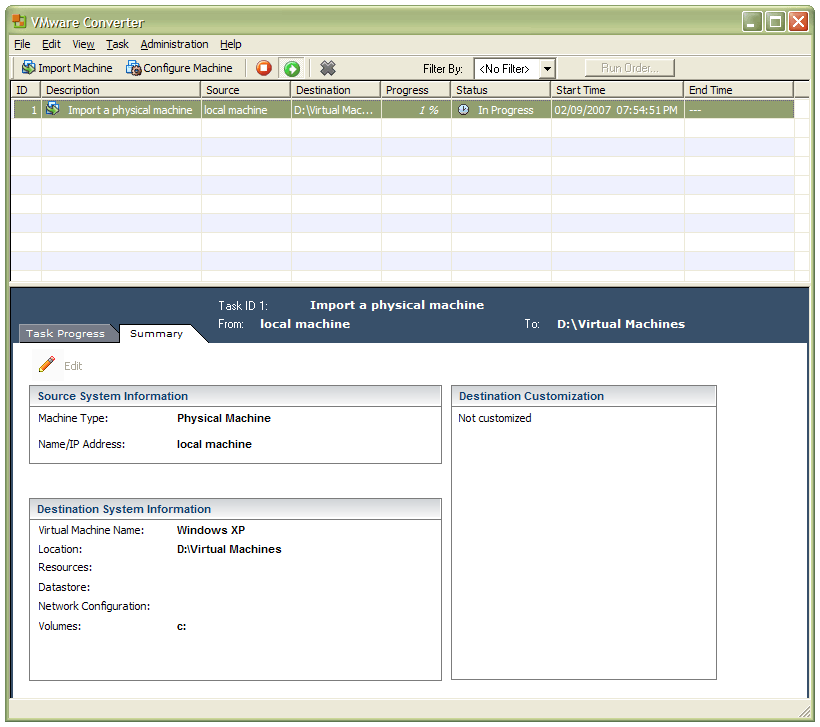TOPIC: VMWARE
A different Firefox II: cross-platform font display issues
18th November 2007One of the things that I have been sorting out on this blog is how the fonts appear in Firefox running on Ubuntu. Even with the same fonts and the same browser, serif fonts were being displayed smaller and appeared more fuzzy in Linux than on Windows. And that's even with the font sharpening that comes with turning on Ubuntu's visual effects. So, there was a spot of swapping between Ubuntu and Windows (running on VMware) while I was increasing font sizes to improve legibility on the Linux side without things going all Blue Peter on Windows. Along the way, I added a mention of the Ubuntu font ae_AlArabiya in the CSS to further spruce up things. In my earlier web building efforts, I was having to make serif fonts bigger because of those serifs. From the on-screen legibility point of view, there's a lot to be said for sans serif fonts and I may yet alter this blog's theme to use them instead, but I'll ponder the idea a bit more before taking the plunge.
Setting up openSUSE in VMware Workstation
12th November 2007While it should have been as straightforward as following the instructions on the openSUSE website, a bug in VMware Tools derailed things for me. The usual procedure would have you starting by selecting Install VMware Tools from the VM menu before popping into the virtual machine to do the rest. Once binutils, gcc, gcc-c++, kernel-source and make are in place, the next steps should involve using YaST to install the RPM for you to run the vmware-config-tools.pl script from the terminal.
However, a bug in compat_slab.h puts a stop to any hopes of installing the vmhgfs component. That's needed if you like to enable the shared folders feature; looking in /mnt/hgfs then would get you to any shared folders. While everything else will be there, why miss out on one piece of functionality when it comes in useful?
Having found a useful thread on the subject, here's my way forward: it is as the expected procedure up to the point of installing the RPM. With VMware Tool installation on a Linux guest, you have two options: use RPM as described or use the compressed tarball. The latter seems the better course. Extract the contents into a folder and navigate to that folder. When there, go into vmware-tools-distrib/lib/modules/source and extract the file vmhgfs.tar. Proceed into the resulting vmhgfs-only contained wherever you put it and perform the following edit of compat_slab.h:
Change
#if LINUX_VERSION_CODE < KERNEL_VERSION(2, 6, 22) || defined(VMW_KMEMCR_HAS_DTOR)
to
#if LINUX_VERSION_CODE <= KERNEL_VERSION(2, 6, 22) || defined(VMW_KMEMCR_HAS_DTOR)
After that, recreate and replace vmhgfs.tar before issuing the following command in the terminal window while in the vmware-tools-distrib directory: ./vmware-config-tools.pl (anything prefixed with "./" picks up the file from the current working directory rather than where system binaries are stored). Though a kernel compilation will be involved, all the defaults should be sensible. Hopefully, all will work well after this.
Update: I am left with a number of outstanding issues that I need to resolve. Lack of internet access from the VM is one of them, and a constant forgetfulness regarding the nationality of my keyboard (it's British) might be another. In the interim, I have removed VMware tools until I can spend some time setting these to rights. That means internet access has returned, and the British keyboard layout is being interpreted correctly for now...
Choices, choices…
10th November 2007While choice is a great thing, too much of it can be confusing, and the world of Linux is a one very full of decisions. The first of these centres around the distro to use when taking the plunge; you quickly find that there can be quite a lot to it. In fact, it is a little like buying your first SLR/DSLR or your first car: you only really know what you are doing after your first one. Putting it another way, you only know how to get a house built after you have done just that.
With that in mind, it is probably best to play a little on the fringes of the Linux world before committing yourself. It used to be that you had two main choices for your dabbling:
- using a spare PC
- dual booting with Windows by either partitioning a hard drive or dedicating one for your Linux needs.
In these times, innovations such as Live CD distributions and virtualisation technology keep you away from such measures. In fact, I would suggest starting with the former and progressing to the latter for more detailed perusal; it's always easy to wipe and restore virtual machines anyway, so you can evaluate several distros at the same time if you have the hard drive space. It also a great way to decide which desktop environment you like. Otherwise, terms like KDE, GNOME, XFCE, etc. might not mean much.
The mention of desktop environments brings me to software choices because they do drive what software is available to you. For instance, the Outlook lookalike that is Evolution is more likely to appear where GNOME is installed than where you have KDE. The opposite applies to the music player Amarok. Nevertheless, you do find certain stalwarts making a regular appearance; Firefox, OpenOffice and the GIMP all fall into this category.
The nice thing about Linux is that distros more often than not contain all the software that you are likely to need. However, that doesn't mean that it is all on the disk and that you have to select what you need during the installation. Though there might have been a time when it might have felt like that, my recent experience has been that a minimum installation is set in place that does all the basics for you to easily add the extras later on an as needed basis. I have also found that online updates are a strong feature too.
Picking up what you need when you need it has major advantages, the big one being that Linux grows with you. You can add items like Apache, PHP and MySQL when you know what they are and why you need them. It's a long way from picking applications of which you know very little at installation time and with the suspicion that any future installation might land you in dependency hell while performing compilation of application source code; the temptation to install everything that you saw was a strong one. The "learn before you use" approach favoured by how things are done nowadays is an excellent one.
Even if life is easier in the Linux camp these days, there is no harm in sketching out your software needs. Any distribution should be able to fulfil most if not all of them. As it happened, the only third party application that I have needed to install on Ubuntu without recourse to Synaptic was VMware Workstation, and that procedure thankfully turned out to be pretty painless.
Restoring Anquet Mapping
4th November 2007One of the issues with an upheaval like that which I have experienced over the last week is that some things get messed up. Because of my hillwalking, I have electronic mapping for planning my excursions into the outdoors. My choice for this has been Anquet; I evaluated it, and it did what I needed. While I could have gone further with the evaluation, I couldn't be bothered with the hassle. Since it's a Windows-only offering as far as I know, good old VMware really proves its worth for this.
Though the software itself is a free download, it's the maps where they make their money, particularly with the 1:25000 scale mapping. I have a lot of 1:50000 mapping so it was with some disappointment that I discovered that it was no longer usable because licences had got lost. Some of the data files needed updating anyway, so I went ahead and did that to get something back. While that exercise cost me some money, I got licences and unlocking was possible. For the mapping where there were no updates, I needed to delete it and download it again, a slow process taking up many hours due to the size of the files and the way that Anquet delivers them. The updating had taken a similar amount of time.
At the end of this, all was well again. However, it would have been better if the licences hadn't disappeared and Anquet had a better way of restoring things than they do. I shouldn't have had to re-download several gigabytes of data, even if it was better than having to fork out more cash to replace what I had.
Turning the world on its head: running VMware on Ubuntu
2nd November 2007When Windows XP was my base operating system, I used VMware Workstation to peer into the worlds of Windows 2000, Solaris and various flavours of Linux, including Ubuntu. Now that I am using Ubuntu instead of what became a very flaky XP instance, VMware is still with me, which I am using it to keep a foot in the Windows universe. In fact, I have Windows 2000 and Windows XP virtual machines available to me that should supply my Windows needs.
An evaluation version of Workstation 6 is what I am using to power them and I must admit that I am likely to purchase a licence before the evaluation period expires. Installation turned out to be a relatively simple affair, starting with my downloading a compressed tarball from the VMware website. The next steps were to decompress the tarball (Ubuntu has an excellent tool, replete with a GUI, for this) and run vmware-install.pl. I didn't change any of the defaults and everything was set up without a bother.
In use, a few things have come to light. The first is that virtual machines must be stored on drives formatted with EXt3 or some other native Linux file system rather than on NTFS. Do the latter, and you get memory errors when you try starting a virtual machine; I know that I did and that every attempt resulted in failure. After a spot of backing up files, I converted one of my SATA drives from NTFS to Ext3. For sake of safety, I also mounted it as my home directory; the instructions on Ubuntu Unleashed turned out to be invaluable for this. I moved my Windows 2000 VM over and it worked perfectly.
Next on the list was a series of peculiar errors that cam to light when I was attempting to install Windows XP in a VM created for it. VMware was complaining about a CPU not being to run fast enough; 2 MHz was being stated for an Athlon 64 3000+ chip running at 1,58 GHz! Clearly, something was getting confused. Also, my XP installation came to a halt with a BSOD stating that a driver had gone into a loop, with Framebuf fingered as the suspect. I was seeing two symptoms of the same problem and its remedy was unclear. A message on a web forum put the idea of rebooting Ubuntu into my head, and that resolved the problem. For now, I'll be keeping an eye on it, though.
Otherwise, everything seems to be going well with this approach, and that's an encouraging sign. It looks as if my current Linux-based set up is one with which I am going to stay. This week has been an interesting one already, and I have no doubt that I'll continue to learn more as time goes on.
Switching from Windows XP to Ubuntu
30th October 2007After a pretty rotten weekend attempting to keep Windows XP running, I finally lost the will to persevere and began yearning for stability. That has taken me into the world of Ubuntu; I am writing this in Firefox running on the said Linux distribution. Thanks to the wonders of VMware, I have been able to observe the swish and slick nature of Ubuntu, and I must that it did sway me. Installation has been slick and efficient and is a dream compared to XP, let alone previous Linux incarnations that I have encountered over the years. Start up is also speedy. All in all, there appears to be a certain confidence about the OS that was sadly absent from my Windows experience in recent times.
Still, I am not deserting the world of Windows completely, though. As it happens, I installed Ubuntu on a spare hard drive that I had, so the Windows installation is still out there. In addition, VMware virtual machines should allow me to stay in there without the ever present risk of a PC getting rendered inoperable. There is also the unfinished business of making myself at home on Ubuntu, hopefully without my wrecking anything. I have yet to give my hardware a full workout to check that all is well. Setting up a web development capability is also on the cards, as is getting those virtual machines. Assuming that there are no showstoppers, it could be an interesting ride.
Onto Norton 360…
20th October 2007
ZoneAlarm cut off VMware's access to the internet, so it was time to reinstall it. However, I messed up the reinstallation and now there seems no way to reinstate things like they were without tampering with my Windows XP installation status, and I have no intention of doing that. The thing seems to think that it can start a TrueVector service that does not exist.
Since I have to have some security software on board, I made a return to the Symantec fold with my purchase of Norton 360. That does sound extreme, but I have been curious about the software for a while now. You get the usual firewall, antivirus and antispam functions with PC tuning, anti-phishing and backup features available as well. It is supposed to be unobtrusive, so we'll see how it goes from here.
Update:
PC Pro rates the software highly, while Tech.co.uk accuses it of being bloatware. Nevertheless, the only issue that I am having with it is its insistence on having Microsoft Update turned on. For now, I am sticking with Shavlik's NetChk Protect, especially seeing what Microsoft has been doing with its update service. Have a look at Windows Secrets.com to see what I mean. Other than that, it seems to working away in the background without intruding at all.
Is Apple ditching Windows 2000?
11th October 2007Having had a brainwave of using my Windows 2000 VM to play music without impacting the rest of my PC's working, I made the discovery that a bit of digging was required to find a version of iTunes and QuickTime that work with Win2K. Google delivered the goods, so here are the links:
It all reminds me of a post that I wrote a few months back, but iTunes is now working and, thanks to VMware's Shared Folders functionality, using the host PC's digital music collection. I'll be seeing how the ring-fencing goes...
How to access host files in VMware Virtual Machines using Shared Folders
9th October 2007I am very surprised at myself for not realising until recently that there is a way to make host data visible to a guest operating system installed in a VMware virtual machine other than resorting to using flash drives, CD's, DVD's and the like. Though you can copy and paste from the host into the VM, I have found that to be hit-and-miss at times. It was a revelation to find VMware's Shared Folders function. My suspicion is that you need VMware Tools installed in the guest operating system to make it work, which may not be trivial for some Linux distributions or UNIX. However, I was using it with a Windows 2000 guest and a Windows XP host, and it worked like a dream.
What you see below are the shared folder settings in the host's VMware interface for that virtual machine. Just clicking on the Add... button brings up a wizard that will set up the shared folder for you; it's all very user-friendly. Look for the Edit virtual machine settings link on the VM configuration page, click that and pop over to the Options tab and this what you can get.

The result of the above spot of configuration appears in Windows Explorer like it does below. Not only are the shared folders accessible in this way, but you can also map drive letters as if they were network resources, a very nice feature. It is definitely more accessible than working out Windows networking and getting things to happen that way.

From real to virtual…
9th February 2007
In a previous entry, I mused over a move from Windows to Linux, a suggestion being that Fedora Core Linux would be my base operating system with Windows installed in a Xen virtual machine. That, of course, led me to wonder how I would swap my current situation about: Linux in VM, Windows as host. Meantime, I discovered something that makes the whole process a little easier: VMware Convertor.
The Starter version can be downloaded free of charge, while the Enterprise edition comes with VirtualCenter Management Server for corporate use. What it does is to make a virtual version of a real computer, a process that takes drive imaging much, much further. I have given it a whirl and the conversion seems to go well; the only thing left is for me to fire it up in VMware Workstation - I believe that Player and Server will also run the VM that is created and, like Convertor Starter, they also can be downloaded free of charge; Workstation does everything for me, so I haven't looked beyond it, even though it did cost me money all those moons ago - and get through licence activation issues without leaving me with no authorised Windows installation.